What do you do when you need an answer quick? You google it.
It’s little wonder that the company name was verbed by Merriam-Webster way back in 2006. Just a few years after its launch, Google was generating as many searches in a second as it once did in a day. Today, the company’s customer base includes over 85% of the search engine market and serves about 40,000 searches per second—and that number is only climbing.
Now, with so many of us working online, visual design and creating a great user experience are more important than ever.
And Google had a head start there, too.
If you’ve ever visited Google.com or one of its regional counterparts (and let’s be real, who hasn’t?), you’ve probably noticed that the logo can be a bit of a changeling. Sometimes the letters are warped to fit into a static image, other times a slideshow is waiting at the click of a button. Since 2010, there are even interactive games.
These Google Doodles started in 1998. While they were away at the Burning Man festival, Google founders Larry Page and Sergey Brin put up the festival’s logo to effectively serve as a playful out-of-office message. Since then, Doodles have evolved into a daily treat for visitors around the globe, taking on new forms, adapting to unique cultures, and resonating with customers for both satisfaction and loyalty.
Alyssa Winans is a Google Doodler and freelance artist based in San Francisco. She shared a peek behind the curtain into how the world’s favorite search engine manages such a creative project.

How are Google Doodles created?
We launch Doodles across a variety of formats: static, animated GIF, slideshow, video, and interactive. We have Doodles that take years of development (especially games) and others we create in real time.
Typically, Google Doodles are planned about a year out. Ideas come from our creative teams, as well as the public. Sometimes, we even hold contests to engage particular demographics (like kids) or themes (such as kindness).
The basic process usually begins with ideation and sketches. We’ll then do color drafts to check the palette before moving on to final art. Interactives will also undergo rigorous testing to best optimize the user’s experience.
How does Google measure the ROI on Doodles, especially ones that take a long time?
Surprise and delight are very hard things to measure! We look at a variety of things to determine this. If people overwhelmingly seem excited, pleasantly surprised, or interested in knowing more, we feel there’s a lot of success in that.
How does Google handle cultural sensitivity for Doodles that appear in different countries?
We partner with Googlers from local teams around the globe. They are involved from ideation to sketches to final art to make sure we’re making the Doodle as culturally appropriate and relevant as possible to the country. We also often invite local guest artists to produce Doodles for special occasions.
When I’ve personally worked on these international projects, one of the key components is research. For example, even if the same holiday is celebrated across different countries, there can be very different local traditions! So we have to keep that in mind.
How many people does it take to create a Google Doodle?
It actually takes a lot of folks to create a Google Doodle, even beyond just the actual creation of the Doodle! For a static Doodle, which typically has only one artist working on it, the whole team will look it over and give input. We also have a whole team of engineers who make sure it launches correctly. For our big projects, we work with partners and collaborators that expand our development group beyond the immediate Doodle team.
How did you become a Doodler?
I actually responded to a tweet asking for portfolios back in early 2015. The team liked my art and brought me in for an informal chat to discuss my previous work. Six months later, I joined the team.
Has the user focus of your Doodler day job influenced your work as a freelance artist?
A little bit! I’m sure when I work with clients, my thoughts about what might be received well are probably informed by my Doodle experience. However, sometimes that encourages me to be more selfish in my personal work, since it’s the only time I get to really turn off those thoughts about external opinions and reactions.
What makes the Google Doodles user experience so successful?
I think that technology can often be frustrating or even overwhelming to interact with, so there actually is a great appetite for surprising moments of warmth or delight. I also think the excitement of learning something new and unexpected can be powerful and infectious, which is part of why people still enjoy Doodles after so many years.



